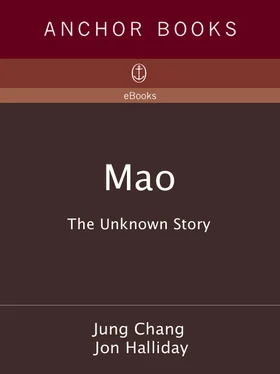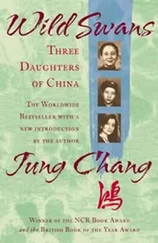Mao was also resourceful in making people “volunteer” to join the Red Army. When one cadre had difficulty getting people to enlist, Mao told her to “find counter-revolutionaries within three days.” She did, and those scared of falling foul of the regime joined up. In one district, the man in charge of conscription failed to produce enough conscripts. Mao had this man, Cai Dun-song, brought to him, and had him worked over, most likely tortured, as Cai “confessed” to having formed an “anti-Communist brigade.” A mass rally was held at which Mao announced the confession, and Cai and a number of others were executed on the spot. A cadre who had worked with Cai said that afterwards “in less than half a month, I enrolled more than 150 people.”
CHINA’S FIRST RED STATE was run by terror and guarded like a prison. A pass was needed to leave one’s village, and sentries were ubiquitous round the clock. One person who did have a chance of getting away was the manager of state monument-building who had access to cash. He took 246.7 yuan — enough to buy a pass and pay contacts. But before he could make his getaway, he was arrested. He then managed to break out of jail, with the collusion of two senior cadres, one of them a man who had seen his brother killed as AB. The manager was caught and brought before a kangaroo court attended by hundreds of people, then executed. Old-timers recalled that not only was anyone “trying to flee to the White area” killed, but sometimes “if a prisoner escaped, the jailer was executed.”
In this prison-like universe, suicide was common — an early wave of what was later to grow to a flood throughout Mao’s reign. The number of suicides was so staggering, even among officials, that the regime had to tackle it publicly, as proclaimed by a slogan: “Suicides are the most shameful elements in the revolutionary ranks.”
Even a very high-ranking officer, Yang Yue-bin, a favorite of Mao’s, was desperate enough to flee and defect to the Nationalists. He gave away the location of Party leaders’ houses. The Nationalists bombed the site, and the leaders had to decamp wholesale.
Ordinary people had more chance to escape if they lived on the edge of the Red region, and some grassroots cadres who hated the regime organized mass escapes. Any cadre under the slightest suspicion of being unreliable would be transferred away from the outlying districts at once. Many waited until the Nationalists attacked and then tried to go over. In the last days of the Red state, when the Nationalists were closing in, whole villages rebelled, and started to attack the Red Army as it retreated, wielding the only weapons they had, knives and spears, as all firearms had been rounded up by the regime.
The state’s response was to be merciless and not to take the slightest chance. At its nadir, even everyday social intercourse and hospitality could bring death. “No family was allowed to have visitors to stay overnight,” veterans recalled. “Any family found to have done so was killed together with the visitor.”
The Ruijin base, the seat of the first Red state, consisted of large parts of the provinces of Jiangxi and Fujian. These two provinces suffered the greatest population decrease in the whole of China from the year when the Communist state was founded, 1931, to the year after the Reds left, 1935. The population of Red Jiangxi fell by more than half a million — a drop of 20 percent. The fall in Red Fujian was comparable. Given that escapes were few, this means that altogether some 700,000 people died in the Ruijin base. A large part of these were murdered as “class enemies,” or were worked to death, or committed suicide, or died other premature deaths attributable to the regime. The figure of 700,000 does not include the many deaths in the large areas the Reds occupied for intermittent periods, or the huge number of deaths in the five Red bases in other parts of China that came under Ruijin.
Years later, locals would point out to travelers mass graves and derelict villages. People who lived under China’s first Communist regime rejected it. When the first Russian intelligence officer visited the area immediately after the Communists took it in late 1949 the newly arrived Party chief told him that in all Jiangxi “there was not one member of the CCP.”
The nominal Party No. 1, Hsiang Chung-fa, had been executed by the Nationalists that June, after a tip-off which the Nationalist intelligence chief U. T. Hsu strongly suggested had come from the Communists themselves. At first Hsiang refused to admit he was the CCP No. 1. “And, seeing this rather stupid-looking man,” Hsu wrote, “we felt we could well be mistaken. But a colleague said that … when Hsiang was a sailor, he had been addicted to gambling, and once when he had lost every penny, he vowed to kick the addiction, and chopped off the tip of the little finger of his left hand … The man’s left little finger did indeed have a chunk missing …” After Hsiang was identified, he went down on his knees to beg for his life, “and at once gave us four top addresses.” Chou En-lai later remarked that Hsiang’s fidelity to communism could not be compared even to the chastity of a prostitute.
Gong’s devastating memoir was published in Hong Kong in 1954. The post-Mao president of China, Yang Shang-kun, himself a witness to the Ruijin time, acknowledged to a small circle that the memoir was true, though it was banned in China. However, Gong was allowed to go back and live in the Mainland in 1991, age ninety.
In 1983, after Mao was dead, 238,844 people in Jiangxi were counted as “revolutionary martyrs,” i.e., people who had been killed in wars and intra-Party purges.
10. TROUBLEMAKER TO FIGUREHEAD (1931–34 AGE 37–40)
WHEN MAO WAS inaugurated as president of the Red state, he had in fact lost his former absolute control over the area, and especially over the Red Army. Moscow had appointed Zhu De the army chief. Moreover, as Party secretary, Chou En-lai was the No. 1. Mao refused to fit into a collective leadership and tried intimidation. His colleagues fought back and accused him of a multitude of sins, even of adopting a “kulak line,” an accusation Mao himself had used to send many Jiangxi Reds to their deaths. Now he was up against a steel wall. At a meeting after Chou arrived, Mao took the chair and started behaving as though he were still in charge. The others intervened to unseat him, and put Chou in the chair. Very soon Mao asked for “sick leave,” which was happily granted, and he left Ruijin in a sulk at the end of January 1932.
He went off to a commandeered Buddhist temple called Donghua Hill, one of many giant rocks rising out of the plain round Ruijin. Covered with metasequoias, cypresses and pines, and dotted with smooth black stones, the hill sheltered the ancient temple in its luxuriant midst. Here Mao spent the days with his wife, Gui-yuan, and a detachment of guards. It was large and rang with echoes. Moss grew on the damp earthen floor. Outside Mao’s monastery room, leaves fell in the winter wind and rain sank into the cracks of the stone courtyard, bringing out more chill. It was a mournful scene.
Mao had brought with him two iron-clad cases filled with documents, newspaper cuttings, notes, and poems he had composed over the years. When it was sunny, the bodyguards would set out these cases in the courtyard, one on top of the other, and Mao would sit on a makeshift stool reading and rereading the contents, pondering how to reclaim his lost power.
He still received top-level documents daily, along with his beloved newspapers, both Nationalist and Communist. It was from these newspapers that he spotted a golden opportunity — which he may in fact have created himself. Between 16 and 21 February, a “recantation notice” appeared in major Nationalist newspapers, bearing Chou En-lai’s then pseudonym, renouncing communism and condemning the Communist Party, especially for its subservience to Moscow. The CCP office in Shanghai went to considerable lengths to counter the impact, and put it about that the notice was a fake, circulating leaflets to this effect and trying to place statements in the newspapers.
Читать дальше










